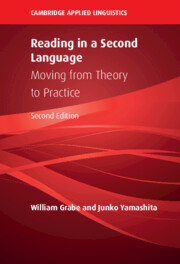Book contents
- Reading in a Second Language
- The Cambridge Applied Linguistics Series
- Reading in a Second Language
- Copyright page
- Dedication
- Contents
- Figures
- Tables
- Preface
- Part I Foundations of Reading
- 1 The Nature of Reading: Defining Reading
- 2 How Reading Works: The Building Blocks of Fluency and Comprehension
- 3 How Reading Works: Comprehension Processes
- 4 Cognitive Issues in Reading
- 5 Neurocognitive Processing and Reading Ability
- 6 Explaining Reading Comprehension: Models of Reading
- Part II Patterns of Variation in Reading
- Part III Developing Reading Comprehension Abilities
- Part IV Expanding Reading Comprehension Skills
- Part V Applications of Reading Research: Instruction and Assessment
- References
- Author Index
- Subject Index
1 - The Nature of Reading: Defining Reading
from Part I - Foundations of Reading
Published online by Cambridge University Press: 01 September 2022
- Reading in a Second Language
- The Cambridge Applied Linguistics Series
- Reading in a Second Language
- Copyright page
- Dedication
- Contents
- Figures
- Tables
- Preface
- Part I Foundations of Reading
- 1 The Nature of Reading: Defining Reading
- 2 How Reading Works: The Building Blocks of Fluency and Comprehension
- 3 How Reading Works: Comprehension Processes
- 4 Cognitive Issues in Reading
- 5 Neurocognitive Processing and Reading Ability
- 6 Explaining Reading Comprehension: Models of Reading
- Part II Patterns of Variation in Reading
- Part III Developing Reading Comprehension Abilities
- Part IV Expanding Reading Comprehension Skills
- Part V Applications of Reading Research: Instruction and Assessment
- References
- Author Index
- Subject Index
Summary
Chapter 1: The Nature of Reading. This chapter provides foundations for the entire book in ways not typically discussed on other reading volumes. It begins with a view of literacy worldwide and then develops the concept of “purposes for reading” because reading skills vary in their activations depending on the reading purpose. A taxonomy of types of reading are discussed, but all types carry a core of reading ability more generally. The taxonomy of “purposes” is also validated by a number of specific research studies. The second major concept introduced is a generalized definition of reading ability, which is described in some depth. A third concept introduced is the “standard of coherence” required for reading purpose and task completion, a fourth concept introduced is a current and widely accepted theory of learning with reference to learning to read (ACT learning theory). The chapter closes with the first installment of a consistent features of the book: “Implications for Instruction.”
Keywords
- Type
- Chapter
- Information
- Reading in a Second LanguageMoving from Theory to Practice, pp. 5 - 23Publisher: Cambridge University PressPrint publication year: 2022

